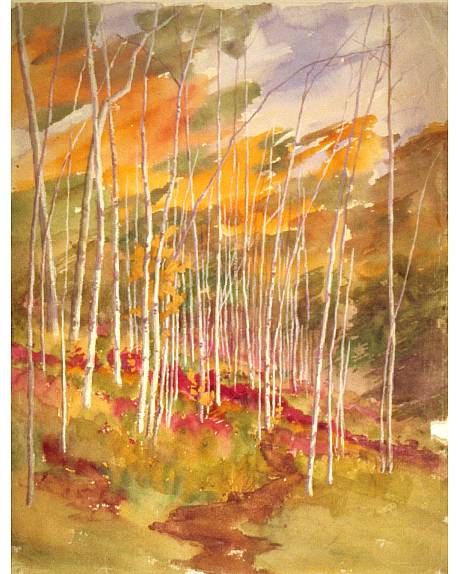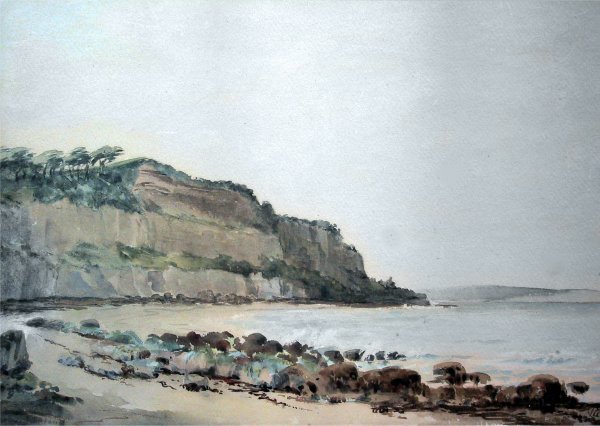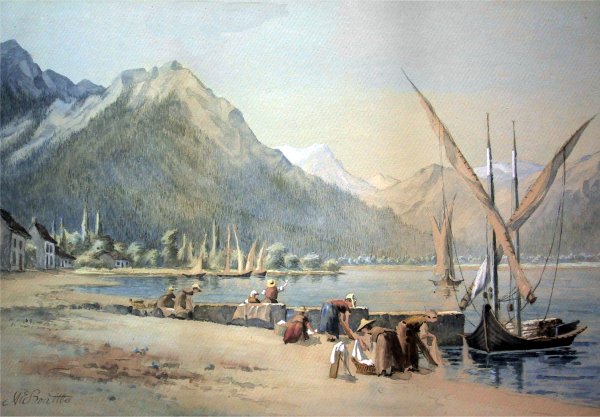Home
Contents
Index
Bottom
Main Entry
Alfred Ernest Boultbee (1864 - 1928)
(written by the Editors)

|
Birch Trees
by Alfred Ernest Boultbee (1864-1928)
|
Alfred, known as Pet, was the third son of Alfred Boultbee Sr. & Caroline Augusta Hamilton. He was born March 26, 1864 at Newmarket, Canada West (now Ontario). His parents moved in 1872 to Peterborough, Ontario, and in 1873 to Toronto, and it is assumed that Alfred received his early education at schools in these locations.
In The Beaver magazine for Summer 1973, there is an article on Alfred by Jennifer Bunting, an historical researcher with the National Archives of Canada. The article is reproduced below, with a few deletions:
-
Although Alfred was educated as an architect, he probably received artistic training beyond that of draughting and design. The technique used in his water-colours is bold and confident, and his love of rich colour contrasts suggests an awareness of European trends. However, his early training was as an architect, not as a painter. In 1884, he was apprenticed as a student of W. G. Storm, Architect, Toronto, and he continued as a draughtsman with this firm until 1887, when he became an independent architect. In 1888, he worked briefly with the office of S. H. Townsend, also in Toronto.
It seems likely that the career as an architect was merely the most acceptable and secure profession into which the talents of young Alfred could be squeezed. His restlessness is evident. From 1889 until 1892, he practised architecture off and on independently. He cannot have been extremely successful, for in 1893 he ceased to advertise himself as an architect, and began instead to advertise himself as an artist. In 1898, caught in the wave of gold-fever, he packed his water-colours and sketchbook and started north towards the Yukon.
He concentrated his efforts on capturing the broad features and surprising colours of the northern landscape. In the twenty pages from his Yukon sketchbook, ..... he captured and expressed what the sourdoughs felt - awe at the grandeur of the northern scenery, which was not `barren' but full of colour and life. He also preserved for us the size and ruggedness of the wilderness which the prospectors crossed in their struggle to reach the gold fields. The muddy trails, the steep mountains,and the miles of muskeg are all recorded.
Like most sourdoughs, he stayed in the Yukon only a year, leaving in the summer of 1899. Back in Ontario, he continued to try to forward his artistic career. He is known to have executed water-colours and oils of scenery in the province of Quebec and also in Europe. However, in 1903, he began once more to advertise himself as an architect.[end of the article by Jennifer Bunting]
Jennifer Bunting organized an exhibition entitled Trails of '98 in which 19 of Alfred's water-colours were included, and which was shown in Ottawa, Edmonton, Whitehorse and Calgary.
Alfred's paintings of the Yukon were acquired by the Public Archives of Canada at an auction at Sotheby's in Toronto in June 1972. An earlier water-colour of Alfred's, Fort York, Toronto, Ontario, was exhibited along with the works of other Canadian artists at the Manoir Richelieu Hotel at Murray Bay, Quebec Province, during the 1940s. In 1970, the Canadian Government purchased the whole collection, and deposited it at the Public Archives of Canada. After cataloguing and checking for deterioration, the paintings were made available for both researchers coming to the Archives and for loans to other institutions. A summary of the catalogue included a history of the paintings, and a brief biography of each painter. A part of Alfred's biography prepared by W. Martha E. Cooke, follows:
-
He exhibited widely, including water-colour and oil landscapes taken at home, in the provinces of Ontario and Quebec, and abroad in England, France and Switzerland; at the Ontario Society of Artists between 1889 and 1896; at the Royal Canadian Academy of Arts (RCA), between 1891 and 1897; and at the Art Association of Montreal (AAM), 1897. Following an absence of three years, Boultbee reappears in the 1895 RCA and OSA catalogues, exhibiting European subjects for the first time. The similarity of the RCA and AAM in 1897 by Miss Constance Mary Boultbee, his sister, suggests that she accompanied Alfred in Europe.
By far Boultbee's most archivally significant works - now in the National Archives - are the 25 water-colour sketches taken along the Stikine Trail en route to the Klondike gold fields. The journey, terminating at Dawson, commenced in the early months of 1898. He returned home in the summer of 1899. [end of article by W. Martha E. Cooke of the National Archives of Canada]
Alfred never married. He and his brother Horatio lived on at 35 Crescent Road, Toronto, after the death of their father. Alfred died December 7, 1928 and is buried in St. James' Cemetery, Toronto.
| Below are images of two Alfred Boultbee water-colours very kindly reproduced thanks to Colleen Blackwell McMahon who notified us of their existence in 2002. |
 |
 |
References:
Jennifer Bunting Artists of the Klondike (Winnipeg: The Beaver, Summer 1973) p.25.
Martha E. Cooke W. H. Coverdale Collection of Canadiana: Paintings, Watercolours and Drawings (Ottawa: Public Archives of Canada, 1983) p.28.
Main Entry
Home
Contents
Index
Top
©



